NVIDIA GeForce FX 5800 Ultra 128MB
|

As usual, before we proceed to analysis of the new accelerator we
recommend that you read the analytic article scrutinizing the architecture
and specifications of the NVIDIA
GeForce FX (NV30)
CONTENTS
-
General
information
-
Peculiarities
of the NVIDIA GeForce FX 5800 Ultra 128MB video card
-
Test
system configuration and drivers' settings
-
Test
results: briefly on 2D
-
RightMark3D
synthetic tests: philosophy and tests description
-
Test
results: RightMark3D: Pixel Filling
-
Test
results:
RightMark3D: Geometry Processing Speed
-
Test
results:
RightMark3D: Hidden Surface Removal
-
Test
results:
RightMark3D: Pixel Shading
-
Test
results:
RightMark3D: Point Sprites
-
Test
results:
3DMark2001 SE synthetic tests
-
Additional
theoretical information and summary on the synthetic tests
-
Information
on anisotropic filtering and anti-aliasing
-
Architectural
features and prospects
-
Test
results: 3DMark2001 SE: Game1
-
Test
results:
3DMark2001 SE: Game2
-
Test
results:
3DMark2001 SE: Game3
-
Test
results:
3DMark2001 SE: Game4
-
Test
results:
3DMark03: Game1
-
Test
results:
3DMark03: Game2
-
Test
results:
3DMark03: Game3
-
Test
results:
3DMark03: Game4
-
Test
results:
Quake3 ARENA
-
Test
results:
Serious Sam: The Second Encounter
-
Test
results:
Return to Castle Wolfenstein
-
Test
results:
Code Creatures DEMO
-
Test
results:
Unreal Tournament 2003 DEMO
-
Test
results:
AquaMark
-
Test
results:
RightMark 3D
-
Test
results:
DOOM III Alpha version
-
3D
quality: Anisotropic filtering
-
3D
quality:
Anti-aliasing
-
3D
quality in general
-
Conclusion
Architectural features and prospects
So, let's sum up performance of the various units of the NV30 with the
synthetic tests and peep into the future.
| Weak points |
Strong points |
| Narrow memory bus (affects FSAA) |
High speed of vertex calculations where it does nothing with loops
and conditions |
| Low speed of pixel calculations |
High texture sampling and filtering speed |
| Low speed of vertex calculations in case of loops and transitions as
a cost of flexibility |
Markedly accelerated anisotropic filtering |
First of all, NVIDIA should eliminate its weakest point - the throughput
of the 128bit bus. Probably, the next top solution - NV35 - will have a
256bit DDR2 bus, and only this fact can boost up performance in real applications
in FSAA modes by 1.5 times (!). And the low speed of pixel calculations
will likely be put an end to only in the NV40 - no fundamental changes
in the architecture of the pixel pipelines of the NV31/34 or 35 are expected.
Probably, they will use the same units.
We can praise NVIDIA for two things - extremely effective texture units
which perfectly sample multiple textures, and more effective anisotropic
filtering. One more pleasant thing is a working HSR technology.
But there are no freebies. Additional functional flexibility in vertex
processors (dynamic transitions and loops) and pixel processors (long shaders
and a great number of constants, as well as predicates) is achieved at
the expense of performance. While in case of vertex processors it is not
noticeable, in case of pixel ones it can turn into a bottleneck in future
applications. On the other hand, only such flexibility of pixel processors
can help this chip get into Hollywood (realistic effects and almost real-time
rendering). I hope the new drivers will be able to improve the situation
with pixel shaders. As well as with VS 2.0. It will be important for all
chips of the NV3x architecture the mainstream models of which (NV31/34)
will become widely popular for a long time.
3D graphics, 3DMark2001 game tests
3DMark2001, 3DMARKS
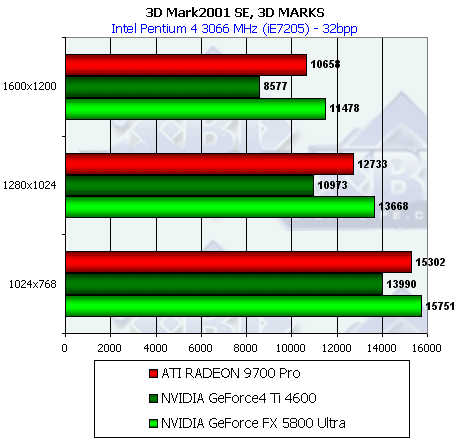

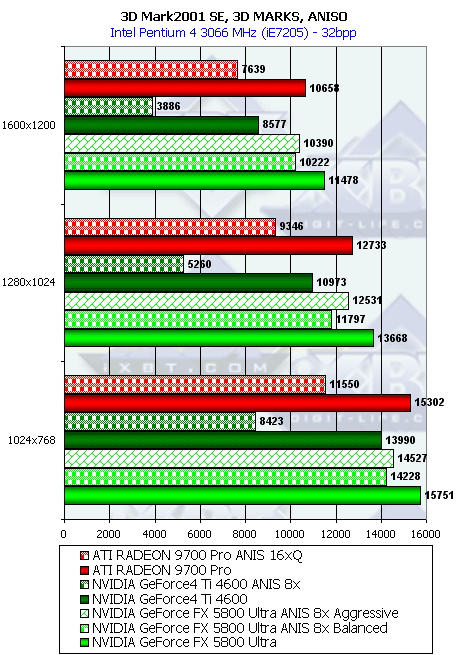


Sometimes the GF FX loses in the tough AA modes, but on the whole the NVIDIA's
solution is ahead, especially in the toughest one: AA + anisotropy. Well,
the faster anisotropy helps a lot.
3DMark2001, Game1 Low details
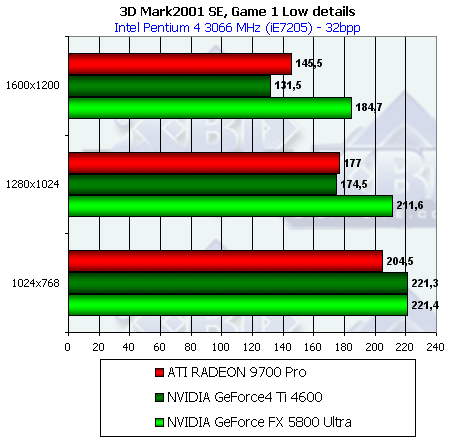

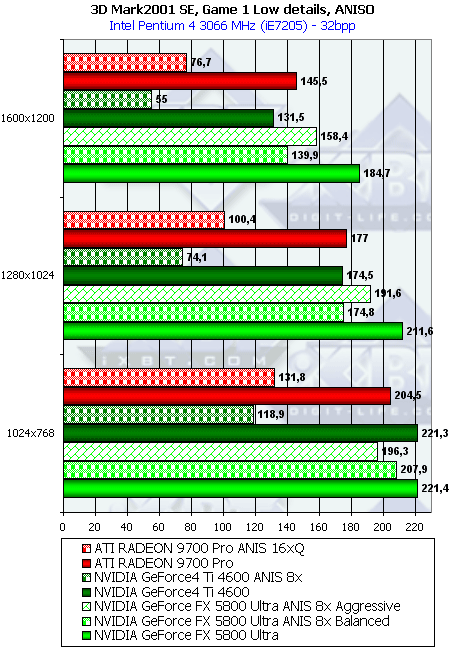


Excellent scores in case of anisotropy, a marginal lead without loads and
a perfect victory over the R9700Pro in the toughest mode of AA + anisotropy.
The AA 6xS revealed the weakness of the memory bus of the NV30.
3DMark2001, Game2 Low details
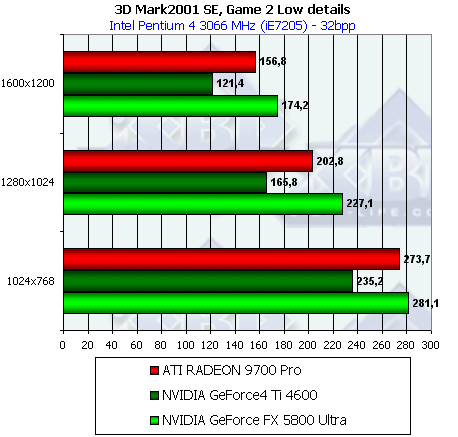

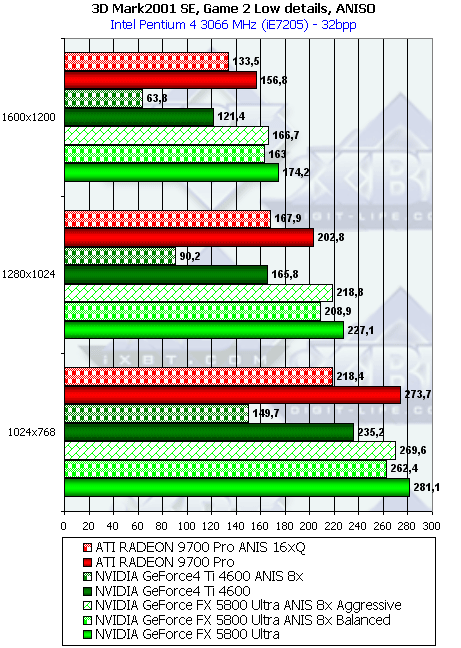


In spite of the victory with the anisotropic filtering, the lead is very
small, and in high resolutions it even loses in the tough modes (probably,
because of the defeat in the AA mode).
3DMark2001, Game3 Low details
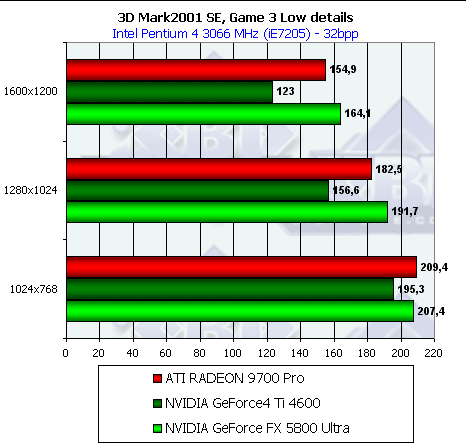




It's similar here.
3DMark2001, Game4
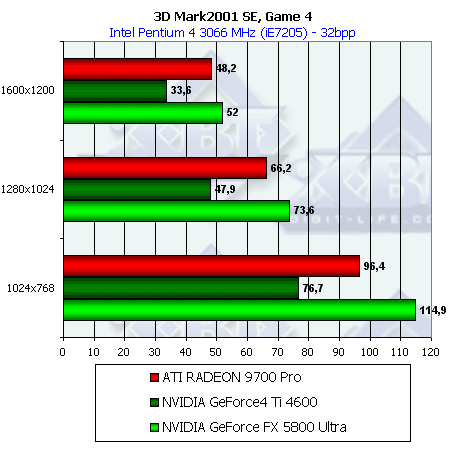

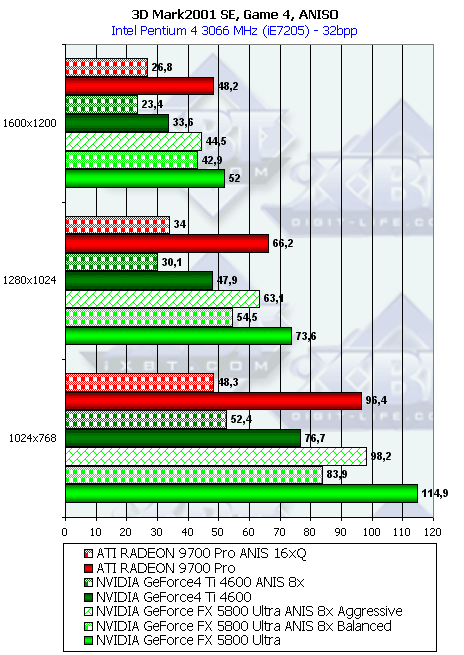


Here NV30 performs well (except the situation with AA 6xS - it's because
of the combination of the fast MSAA and very slow SSAA).
In general, in the 3DMark2001SE the NV30 scores good results. Of course,
we expected more taking into account the difference in the cores' frequencies,
but the bottleneck of the NVIDIA's solution doesn't let the things be so
bright. Where is the promised frame buffer compression in case of AA and
hyper speeds? At present, you can see it only at 4x. But this mode is enough
for today. And quality will be examined later.
[ Previous Part (5) ]
[ Next Part (7) ]
Alexander Medvedev ( unclesam@ixbt.com)
Write a comment below. No registration needed!
|
|


























